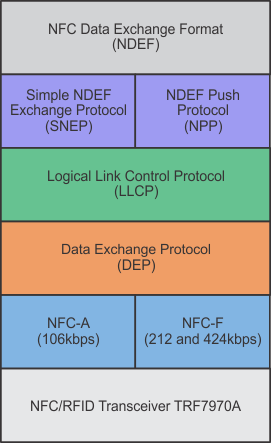SLOA192B April 2014 – March 2019 TRF7970A , TRF7970A
-
NFC active and passive peer-to-peer communication using the TRF7970A
- Trademarks
- 1 Introduction
- 2 Initial RF Collision
- 3 TRF7970A Register Settings
- 4 Peer-to-Peer at 106 kbps
- 5 Peer-to-Peer at 212 kbps and 424 kbps
- 6 Hardware Description
- 7 Passive and Active Peer-to-Peer Firmware Example
- 8 Quick Start Guide
- 9 Operational Overview
- 10 Peer-to-Peer Interoperability Results
- 11 Conclusion
- 12 References
- Revision History
1 Introduction
The TRF7970A supports three modes: reader/writer, card emulation, and peer-to-peer. This document describes how to use the TRF7970A in peer-to-peer (P2P) active or passive. P2P requires two NFC-enabled devices to communicate using technologies NFC-A or NFC-F at baud rates of 106 kbps (NFC-A), 212 kbps (NFC-F), or 424 kbps (NFC-F). The transceiver that is initially polling and initiates the communication is the initiator. The transceiver that is initially listening is the target.
The initiator always generates the RF field for both active and passive communication modes. However, the target generates its own RF field only for active mode (while the initiator's RF field is disabled) and load modulates the initiator's RF field in passive mode. After the technology selection for either mode has been completed, the higher layers are the same (as shown in Figure 1). The NDEF Push Protocol (NPP) was commonly used on Gingerbread Android NFC devices as the protocol to push NDEF messages from one NFC device to another; however, the Simple NDEF Exchange Protocol (SNEP) has become the standard on Ice Cream Sandwich Android NFC devices and onward.
 Figure 1. Peer-to-Peer Layers Including the PHY (TRF7970A)
Figure 1. Peer-to-Peer Layers Including the PHY (TRF7970A) A 16-bit and a 32-bit microcontroller are used to interface with the TRF7970A to demonstrate a reference example of the peer-to-peer mode. The firmware supports flexible functions that let the user enable or disable different peer-to-peer modes and technologies. The firmware supports both initiator and target for active and passive communication at baud rates of 106 kbps, 212 kbps, and 424 kbps. Additionally, the firmware can send and receive NDEF messages from NFC-enabled smart phones with SNEP.
Table 1 lists the NFC-enabled devices used to validate the firmware.
Table 1. NFC Enabled Devices Used to Test Peer-to-Peer
| Smartphone Model (Release Date) | Operating System | Kernel Version |
|---|---|---|
| Samsung Galaxy Nexus (Nov 2011) | Android 4.3 | 3.0.72 Jun 7 2013 |
| Samsung Galaxy S3 (T-Mobile) (May 2012) | Android 4.0.4 | 3.031 Oct 31 2013 |
| Asus Nexus 7 (July 2012) | Android 4.4.2 | 3.1.10 Nov 20 2013 |
| Samsung Galaxy Note 2 (Sept 2012) | Android 4.3 | 3.0.31 Nov 19 2013 |
| AU Arrows Fujitsu FJL21 (Oct 2012) | Android 4.0.4 | 3.0.21 Oct 16 2012 |
| Nokia Lumia 820 (Oct 2012) | Windows 8 | 8.0.10211.204 |
| HP Elite Tablet (Nov 2012) | Windows 8 | Windows 8 Pro |
| Samsung Nexus 10 (Nov 2012) | Android 4.4.2 | 3.4.39 Nov 20 2013 |
| Google Nexus 4 (Nov 2012) | Android 4.3 | 3.4.0 Nov 20 2013 |
| Samsung Galaxy S4 (April 2013) | Android 4.3 | 3.4.0 Nov 16 2013 |
| Hisense Sero 7 Pro (June 2013) | Android 4.2.1 | 3.1.10 |
| Asus Nexus 7 (July 2013) | Android 4.4 | 3.4.0 Dec 11 2013 |
| Google Nexus 5 (Oct 2013) | Android 4.4 | 3.4.0 Nov 20 2013 |